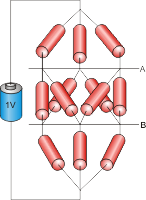This problem can of course be solved using the standard network theorems, but there is a simpler method. Note in the diagram below that due to the symmetry of the arrangement, all the nodes at A have the same potential (as do the nodes at B).

In effect, this circuit is equivatlent to one with three parallel resistors ($R_A$) in series with six parallel resistors ($R_{AB}$) in series with three more parallel resistors ($R_B$). The solution then becomes quite simple. We just compute the overall resistance $R$ as
\[ \begin{eqnarray*} R &= & R_{A}+R_{AB}+R_{B}, \\ R_{A} &= & R_{B} = \frac{1}{1+1+1} = \frac{1}{3} \Omega, \\ R_{AB} &= & \frac{1}{1+1+1+1+1+1} = \frac{1}{6} \Omega, \\ R &= & \frac{1}{3} + \frac{1}{6} + \frac{1}{3} = \frac{5}{6} \Omega.\\ \end{eqnarray*} \]
Thus $ I=V/R = 6/5 $ amp.